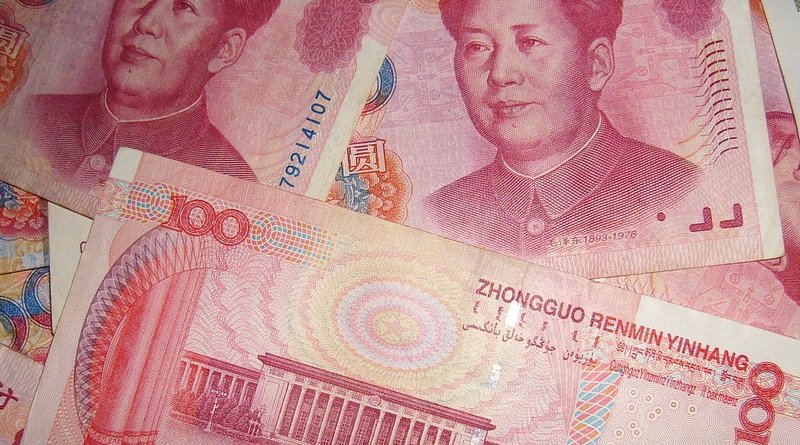New Foreign Investment Law In China: Panic Bell For India And ASEAN – Analysis
Given the downtrend in Chinese GDP growth and loosing the sheen for low cost production hub, China lost the foreign investment attraction. FDI in China witnessed a wafer thin growth. During the four years period of 2015-2018, the annual average growth in FDI in China was 0.2 percent ( US $ 135 Billion in 2015 to US $ 139 Billion in 2018). China lost its paradise of low cost manufacturing base in the world, due to appreciation of Chinese currency yawn and high cost for tackling environment.
China decided to adopt a new Foreign Investment Law (FIL) to resuscitate the growth. FDI is the main pillar for China’s growth. The new FIL will be effective from 1st January, 2020. Existing policies were too old and not conducive to support Chinese new economy, which is reliant on FDI. China is entering a new phase of economic fundamentals with a focus on technology linked development To this end reforms in foreign investment policy were imperative.
Global investors hailed China’s new Foreign Investment Law (FIL) a breakthrough to give new life to the Chinese sagging foreign investment, even though many commentators are dubious on actual implementation.
FDI attraction in China transformed into new sectors. The proportion of FDI in manufacturing and real sectors was declining and larger proportion were invested in high tech areas, like IT, Artificial Intelligence, internet.
New FIL will replace existing three laws of Chinese foreign investment, viz, Chinese –Foreign Equity Joint Venture Law, Wholly Foreign Equity Enterprises Law and Chines- Foreign Contractual Joint Venture Law.
The new FIL exhibits four interesting characteristics to attract foreign investment. They are national treatment to foreign investors (barring negative list), banning mandatory transfer of technology, promising better protection to intellectual property rights and ensuring equal rights to government procurement.
The set back in China’s FDI attraction was further aggravated by USA’s high tariff trade war, roiling China’s big advantage as an export hub.
Many MNCs either pulled out of China or adopted China+1 strategy. Instead of closing plants in China, they shifted to alternative low cost manufacturing bases in ASEAN and India. Thus, instead of relying on China as their sole beachhead in Asia, MNCs shifted their operations in ASEAN and India. Best Buy, an American electronics retailer and Media Market, a German company, put their shutters down. Revlon and L’Oreal stopped selling Garner brand in China. Tesco, a British retail giant, joined hand with local firm, declining to go alone as a salvage from China risk.
Chinese downturn in FDI attraction leveraged India and ASEAN more competitive destinations for foreign investment. India and ASEAN witnessed surge in FDI flow in the wake of relocation of plants by MNCs from China or expanding their production bases. The noticeable shifts were marked by surge in FDI in Vietnam, Thailand and India, owing to China becoming less attractive.
Singapore became the biggest foreign investor in India in 2018-19, surpassing Mauritius, Japan ,UK , USA. FDI from Singapore doubled during the three years period – from US $ 8.7 Billion in 2016-17 to US $ 16 Billion 2018-19.
It is believed that surge in Singapore investment in India is the transition of investment from China. Singapore is the second biggest foreign investor in China, after Hong Kong. But, its investment in China plunged after China dipped into low growth trajectory. During 2014 to 2017, Singapore investment flow in China dropped by over 73 percent. This depicts Singapore’s overseas investment choice of shifting from China to India, after China lost its sheen.
Close on the wheel, Chinese investment too sparked in India. It increased by over 145 percent in 2018 over 2017.
In the run up, many Japanese investor opted for low cost ASEAN countries. In between 2016 and 2018, Japanese investment in Vietnam and Thailand soared by 180 percent and 89 percent respectively. Chinese investment followed suit. It increased by over 26 percent in Vietnam in between 2017 and 2018.
China’s new FIL is likely to set a new template for FDI in China. With more doses of liberalizations, which will remove a number of irritants for investment in China, MNCs will have a second thought for dislocation of their plants or follow China+1 strategy for expansion. The bounce back in their wish list is feared to push a panic bell for India and ASEAN , who were benefiting from the deterioration of foreign investment climate in China.
FDI in India has been an important success story for Make in India, albeit it failed to be a steam for domestic investors. FDI surged from US 30 Billion in 2014-15 to US$ 44.3 Billion in 2018-19, witnessing a massive leap by over 46 percent within five years. Will the bounce back of foreign investment climate in China due to new FIL impact FDI growth in India?
This raises a debate in the wake of China’s embroilment in trade war with USA. High tariff by USA limits China’s edge over India and ASEAN as an export hub, making Chinese goods costlier. Resolving Sino – USA tariff war in near term is farfetched. From January 2020, disgruntled Trump will go for more 10 percent tariff on China’s US$ 300 billion exports.
Given the situation, FDI in India and ASEAN is unlikely to be affected by China’s new FIL. Nevertheless, India needs to revamp its FDI policy as some major policies like FDI in multi-brand retail, housing construction for mass lurk for openness.
Views expressed are personal

